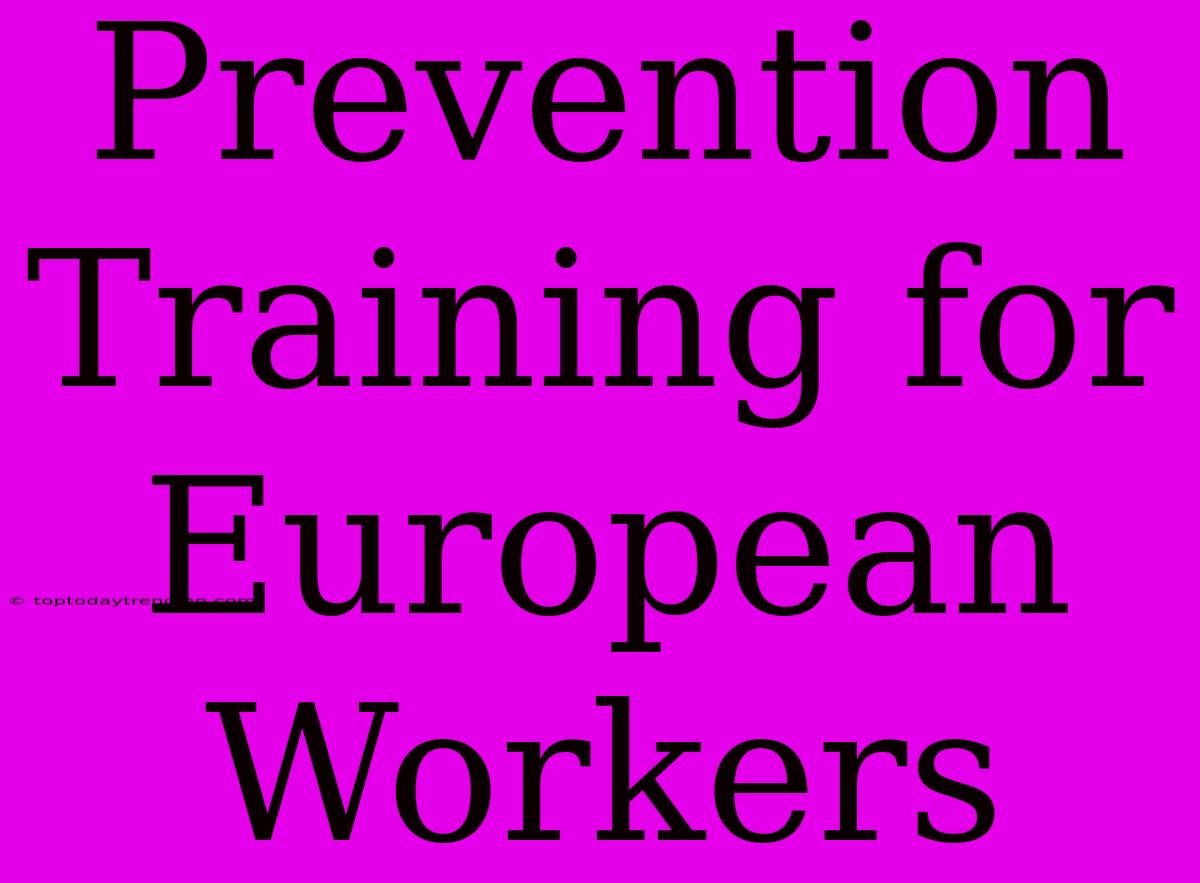Prevention Training for European Workers: A Comprehensive Guide
Introduction
The European Union places great emphasis on the safety and well-being of its workers. Prevention training is crucial for creating a safe working environment and ensuring that workers are equipped with the necessary knowledge and skills to identify, assess, and manage risks. This article provides a comprehensive guide to prevention training for European workers, covering key aspects like legal requirements, training objectives, and best practices.
Legal Framework
The EU Framework Directive on Safety and Health at Work (89/391/EEC) serves as the cornerstone for workplace safety in the EU. This directive requires employers to provide workers with adequate information, training, and instruction to ensure their safety and health at work. Member states have implemented this framework directive through national legislation, resulting in a range of regulations and standards that govern prevention training.
Key Objectives of Prevention Training
Prevention training for European workers aims to achieve several key objectives, including:
- Raising awareness of risks: This involves educating workers about potential hazards and risks associated with their work, helping them understand how to recognize and avoid these risks.
- Developing skills and knowledge: The training equips workers with the necessary practical skills and knowledge to prevent accidents, injuries, and occupational illnesses.
- Promoting a proactive safety culture: Prevention training encourages a positive attitude towards safety, fostering a culture where workers actively participate in identifying and mitigating hazards.
- Complying with legal requirements: Training ensures that employers meet their legal obligations related to workplace safety and health.
Essential Elements of Prevention Training
A comprehensive prevention training program should encompass the following elements:
1. Risk Assessment:
- Identify and evaluate potential hazards: Training should cover methods for conducting thorough risk assessments, including identifying hazards specific to the workplace and work activities.
- Prioritize risks: Workers should learn to prioritize hazards based on their severity and likelihood of occurrence.
- Develop control measures: Training should include techniques for implementing control measures, such as eliminating hazards, using personal protective equipment (PPE), or adjusting work processes.
2. Workplace Safety Practices:
- Safe use of machinery and equipment: Workers should be trained on the safe operation of all machinery and equipment used in the workplace.
- Handling of hazardous substances: Training should cover the safe handling, storage, and disposal of hazardous substances, including appropriate PPE and emergency procedures.
- Ergonomics and posture: Workers should be educated on proper posture, lifting techniques, and work organization to prevent musculoskeletal disorders.
- Fire safety and emergency procedures: Training should cover fire safety procedures, emergency exits, evacuation plans, and first aid.
3. Personal Protective Equipment (PPE):
- Types of PPE: Training should introduce workers to different types of PPE, including respirators, gloves, eye protection, and hearing protection.
- Proper selection and use: Workers should learn how to select the appropriate PPE for specific tasks and risks.
- Maintenance and storage: Training should cover the proper maintenance, cleaning, and storage of PPE.
4. Communication and Reporting:
- Reporting near misses and accidents: Workers should be encouraged to report any near misses or accidents to their supervisor.
- Effective communication: Training should cover the importance of clear and open communication about safety concerns within the workplace.
5. Specific Industry and Job Roles:
- Tailored training: Prevention training should be tailored to specific industry sectors and job roles, addressing unique hazards and risks associated with each.
- Industry-specific regulations: Training should include information on any industry-specific regulations and standards relevant to workplace safety.
Best Practices for Prevention Training:
- Use a variety of training methods: Combine lectures, demonstrations, practical exercises, and interactive simulations to enhance engagement and learning.
- Provide ongoing training: Regular refresher courses and updates on new safety regulations are crucial for maintaining knowledge and skills.
- Encourage active participation: Encourage workers to ask questions, share their experiences, and participate in discussions during training.
- Provide feedback and evaluation: Regular feedback and evaluation of training programs help identify areas for improvement and ensure their effectiveness.
Conclusion
Prevention training is an essential investment in the safety and well-being of European workers. By providing comprehensive training that addresses specific workplace hazards and industry regulations, employers can create a safer working environment and reduce the likelihood of accidents, injuries, and occupational illnesses. This commitment to prevention not only protects workers but also contributes to a more productive and efficient workplace.

